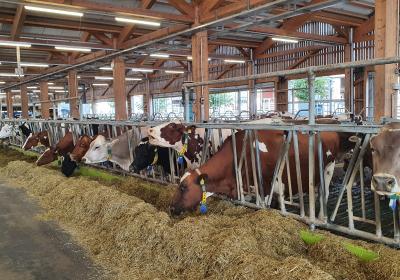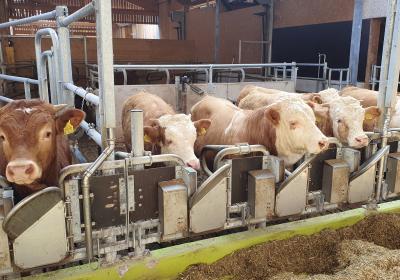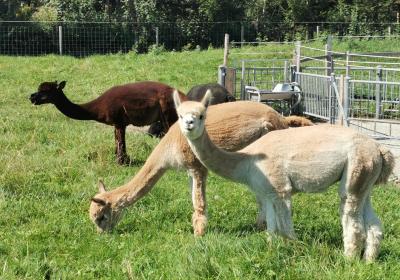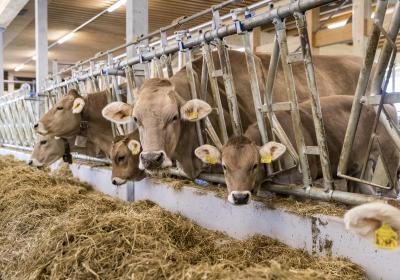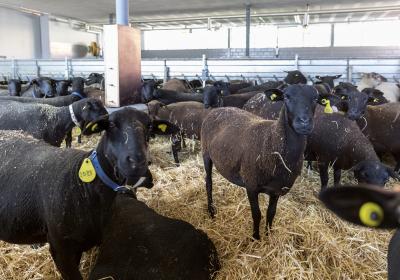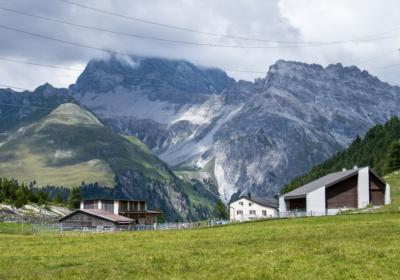Dairy barn with feed storage and silos (Lindau)
The dairy barn can keep two separated herds, of which one herd is used for educational purposes and the other herd for research. The herd used for education has 50 dairy cows and the research herd has 5x14 dairy cows which are kept in 5 compartments (including a spare compartment). The breeds are chosen to cover all the needs of education and research. The education herd is kept in different formats (e.g. various feeding fences, pen dividers etc.) so that students can observe them. This herd is milked with an automatic milking system. The experimental herd is kept in four barn compartments (including a spare compartment) offering space for 14 animals. This herd is kept in one format. It is fed from feed weighing troughs, and each compartment has a concentrated feed station. The cows are milked in a tandem milking parlour.
Besides the facilities for these two herds, the dairy barn has two areas for transiting cows, an area for dry cows and an area for calving. In the upper part of the dairy barn are also facilities belonging to the Vetsuisse faculty of the University of Zurich with treatment and reproduction rooms as well as bays for bulls and sick animals.
The barn
also has feed storage and silos.
Possibilities offered by the dairy barn, interview with Andreas Buri
Andreas Buri explains the possibilities offered by the dairy barn with two herds (in German).
A virtual tour through the dairy barn
Details about the dairy cow barn
Matthias Schick explains the dairy barn (in German).
Youngstock barn (Lindau)
The youngstock barn can keep calves, breeding cattle and store cattle. It has 12 individual igloos and facilities to keep calves in groups. To explore the advantages and disadvantages of a non air-conditioned barn versus a warm barn for keeping calves, both variants are available for a maximum of 40 calves.
A maximum of 78 breeding cattle and 60 store cattle can be kept either in deep litter or free range with cubicle housing. This facility can be optionally equipped with feed scales. Deep litter also allows suckler cows and their calves to be kept, with an option of calf areas.
The youngstock barn will be operational from May 2018.
Alpaca stable
Since August 2021, 11 alpacas are kept in Lindau. The animals are kept in a barn with deep litter and access to a pasture.
Pig unit (Lindau)
The pig unit was built in 2006/2007 and became operational in 2007. Strickhof is a core breeding location for pigs with an incorporated fattening sector which is operated to Specific Pathogen Free (SPF) standards. Any animals placed outside of the pig unit for experiments can therefore not return to the pig unit afterwards. The pig unit contains animals of the French landrace breed, and all pigs are kept compliant with BTS and RAUS standards. Breeding sows and piglets can be fed dry feed, and grower pigs and repair young wet feed. The pig unit offers a total of 105 places for breeding sows and 200 places for grower pigs.
Cow barn (Wülflingen)
The cow barn built in 2002 is open on all sides and offers space for 68 large livestock units, and is RAUS and BTS compliant. The animals can either be kept in deep litter or in cubicle housing.
Cow barn (Früebüel)
The Früebüel site offers a cow barn for 40 light suckler cows and their calves. The barn will be renovated and extended in 2018.
Sheep barn (Früebüel)
The old dairy barn is being renovated and transformed into a new sheep barn in 2017. After spending the summer at Alp Weissenstein, the sheep will spend their first winter in the new barn. It has space for 60 sheep and their lambs.
Barns at Alp Weissenstein
Alp Weissenstein comprises a cow and cattle barn which was built in 1967 and renovated in 2015. Together with the old alp barn which has four freestall barns with a fixed exercise yard, there is great deal of flexibility on how the barns are used for research. The barns offer space for all animals in the case of an onset of winter during the alpine season.





